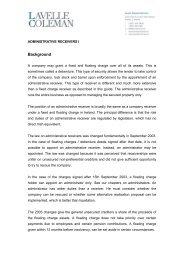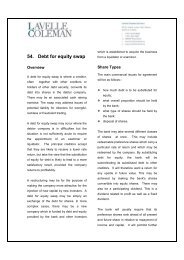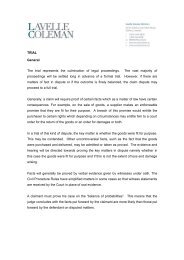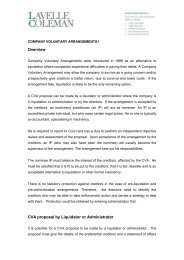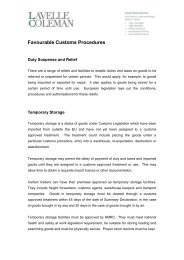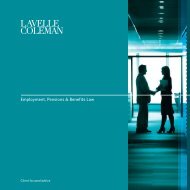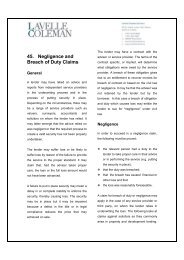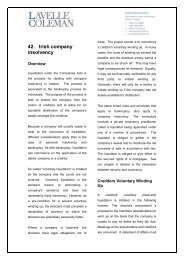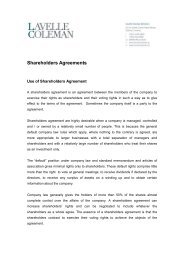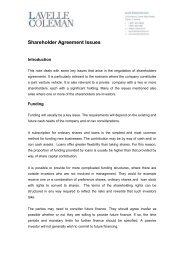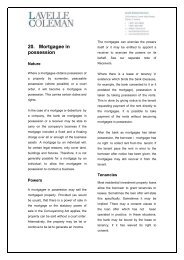OUTLINE OF COURT PROCEEDINGS ... - Lavelle Coleman
OUTLINE OF COURT PROCEEDINGS ... - Lavelle Coleman
OUTLINE OF COURT PROCEEDINGS ... - Lavelle Coleman
Create successful ePaper yourself
Turn your PDF publications into a flip-book with our unique Google optimized e-Paper software.
<strong>OUTLINE</strong> <strong>OF</strong> <strong>COURT</strong> <strong>PROCEEDINGS</strong>BackgroundThe Civil Procedure Rules prescribe the rules for the conduct of litigation. They alsoprovide “practice directions” and “protocols” for some types of disputes which set out theprocedures and practices to be used in those types of disputes. The protocols andpractice directions give guidance and put structure and limitations on how the particulardisputes and claims should be handled. The protocols take on board experience of whatis involved in particular types of disputes so as to ensure insofar as possible, thatdisputes are handled efficiently and that the “wheel is not reinvented” on every occasionLetter of ClaimThe first step in most disputes is for the person making the claim to issue a letter ofclaim. It is no longer possible simply to write a general letter of claim holding back all thedetails of the claim and the basis upon which it will be proved. Where pre-actionprotocols apply, they typically stipulate details and enclosures that must be included in aletter of claim. Generally much greater detail of the dispute is required, than would be thecase in Ireland.The letter should give sufficient concise details to enable the details of the claim to befully understood and investigated. Essential documents must be enclosed. It mustrequire a response within a reasonable period, usually one month. It must identify andask for disclosure of any essential documents and say whether the party wishes to enteron any type of ADR.The pre-action Protocols stipulate that the response to a claim must contain certaindetails. It must answer the claim in detail and state whether or not liability is admitted. Ifliability is denied, reasons should be given. If third parties are alleged to be at fault or
esponsible, they should be identified. It is not permitted to simply deny the claim so as“to put the other party to their proof” i.e. to put them to the expense and exercise ofproving particular point in the claim even though there might be no serious dispute onmany of them.The defendant must give detailed reasons why the claim is not accepted, identifyingwhich contentions are accepted and which are disputed. Copies of essential documentsmust be enclosed. If they are not enclosed there must be justified. The defendant mustspecify whether he is prepared to enter any method of alternative dispute resolutions.Commencing Legal ActionProceedings are commenced by way of County Court or High Court “Claim Forms”. Theforms are less legalistic than in Ireland and are available on-line. The rules for settingout and describing claims are intended to be less technical so that a solicitor should bein a position to prepare the wording without necessarily having to have them prepared bya barrister.The person against whom the claim is made (the defendant) must respond to the claim.The Court, through the Court Offices, has a much greater involvement in serving theClaim Form than in Ireland. The Court itself will usually serve the Claim Form (unlike thecase in Ireland where the parties themselves serve it).The claim form will set out the full claim or alternatively will set out brief particulars of theclaim. In this latter case, where brief particulars only are set out, the claim form must befollowed by a further more detailed claim within 14 days.It is necessary that the claim is fully verified and that the claimant or his legalrepresentative signs to confirm his full belief in the truth of the claim.The claim form is prepared by the claimant's solicitor and sent to the Court Offices whichformally issue it as a legal document. Unlike in Ireland, the Court office itself usuallyserves the documents on the respondent/defendant and usually does so by first class
post. A person making a claim or a person who is the defendant must give an addressfor services within England and Wales. <strong>Lavelle</strong> <strong>Coleman</strong> has an office with an Englishand Wales address for the purpose of service under the Court rules.When a defendant receives a claim he must respond in order to avoid a judgement andorder being made against him by default. Generally, the defendant must answer theclaim by either acknowledging receipt setting out a full defence or admitting the claim inpart or in full within certain time limits. If the defendant simply acknowledges a receipthe must within 28 days of the original claim set out details of his defence. The defencesets out the facts and circumstances by which the defendant claims that the claim isdenied in full or in part or is not valid.Options for DefendantIt is possible for a defendant to admit part of a claim and dispute the rest. When theclaim is submitted the defendant must give personal details and should he make an offerof payment, he must set out whether he is offering to pay in full or by instalments.Under these circumstances he must set out his income and expenditure so the Courtcan consider whether his offer is reasonable.If the claimant accepts the defendant’s offer, he can apply for a Court judgement so thatthe offer will become an Order of Court. A Court Order is enforceable against thedefendant in a number of possible ways. If the claimant rejects the offer, he can apply tothe Court for what he claims is the appropriate Order as to lump sum payment orinstalments etc.. If the claim is for less than £50,000.00 a Court Office rather than theJudge, will decide the rate of payment, without a Court hearing.Court officers or the Judge may make a decision without any hearing. If a hearing isrequested the parties must be given seven days notice. The Court takes into accountthe defendant’s means, statement of means, the claimant’s objections and other relevantfactors.
Where a defendant admits liability but the amount is unspecified, it must be assessed bythe Court. A so called “disposal hearing” is heard, by which the Court determines theextent of damages, compensation or other appropriate order that is to be given.Likewise where the amount claimed is unspecified and the respondent makes an offer itcan either be accepted by the claimant or the claimant can apply to the Court todetermine the amount of the award.Defendant Ignores the ClaimIt will frequently be the case, particularly in debt collection cases that the defendant willhave no valid response to the claim. In this case, the claimant is seeking a Court Orderto the Court so that it can be enforced against the respondent debtor.There is a special procedure for obtaining a Court Order (or “judgement”) in default of anappearance or substantial defence by the respondent. This procedure will be used indebt collection cases. In these cases, a claim has been made and the defendant hasneither acknowledged receipt nor filed a defence within the relevant time limit, it ispossible to obtain a Court Order through the Court office without a formal hearing orprocedure. Where the judgement is for a specified/certain amount a Court will normallygive judgement for the amount due. Where the amount claimed is unspecified, but mustbe judged and determined by the Court in a disposal hearing before a Court Officer orthe judge who will determine the necessary amount of the claim.Where a defendant does not respond to a claim, a Court Order can be given “in default”against him. There are procedures whereby a defendant can later apply to Court tohave the default judgement set aside. It will be necessary to show that there wereactual grounds for disputing the claim.Interest is due on awards either under the original contract or at a special rate fixed oncourt orders and in the case of commercial debts, under the Late Payment of Debts Acts
Contents of Claim, Defence and CounterclaimThe initial claim form or the later statement of case sets out the full details of what isclaimed. This informs the respondent of what is alleged and also puts limits on what isto be proved at the Court hearing if there is one. The defendant sets out a responsewhich must set out which points which are accepted and those which are denied.The purpose of this documentation is to ensure that the matters in dispute are clearly setout and understood in advance of the case going to hearing. It is possible for either sideto request further information and details of the other sides case or their response. Bythe time the matter goes to Court, it should be evident from the documents what isdisputed and what is not disputed.Sometimes the person against whom a claim is made will themselves have their ownclaim arising from the circumstances. This is called a “counterclaim”. The counterclaimarises from the same circumstances as the claim. It may be convenient for the Court tohear the entire matter in a single hearing.A defence sets out the basis on which a claim is denied. It may be that the eventsclaimed never happened or that they did happen but there is some other significantcircumstances which means that no valid claim exists.A counterclaim is different to a defence. A counterclaim is a claim by the respondentclaimed against the claimant or some third party. Sometimes a party sued will have aright of contribution or indemnity from another party. This other party can be broughtinto the proceedings. For example, the person sued may have a right to recover whatmight be claimed from another third party. This third party would usually be brought into the proceedings.
______________________________________________________________________This Guide is intended as an overview and broad outline of the matters covered in it. Its purpose is to informand raise awareness. We are happy to offer specific legal advice on particular circumstances.This Guide should not be relied on as a substitute for comprehensive legal advice with reference to theparticular circumstances.While we have taken due care in the preparation of this publication, we do not accept legal liability as aresult of any reliance placed on anything in this Guide. The reader should rely only on specific legal ortaxation advice.© <strong>Lavelle</strong> <strong>Coleman</strong> 2009



